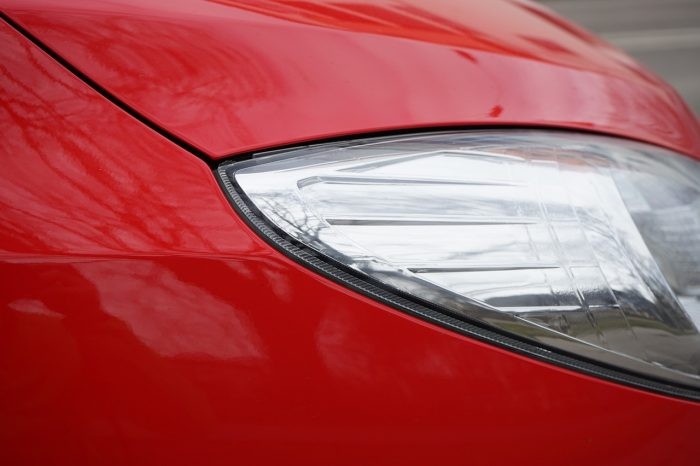Stone chips are an unfortunate reality for car owners, especially those who frequently drive on highways or in areas with gravel roads. The hood of your car, being directly in the line of fire from road debris kicked up by tires, is particularly vulnerable. These seemingly minor blemishes can detract from your vehicle’s appearance and, if left unattended, can lead to more significant problems like rust. Fortunately, repairing stone chips on your car hood is a manageable task, often achievable at home with the right tools and techniques. As your trusted expert from Car Repair Online, I’m here to guide you through the process of effectively repairing stone chips and keeping your car hood looking its best.
Understanding Stone Chips and Why Repairing Them Matters
Stone chips are small areas where your car’s paint has been chipped away, usually exposing the primer or even the bare metal underneath. They are commonly caused by gravel, small stones, and road debris hitting your car at speed. While they might seem like purely cosmetic issues, stone chips can have more serious implications if ignored.
The Causes of Stone Chips on Your Car Hood
The primary culprit behind stone chips is loose debris on the road. This is exacerbated in certain driving conditions:
- Highway Driving: Higher speeds mean more force when road debris impacts your car. Vehicles in front of you can easily flick up stones and gravel directly onto your hood.
- Winter Roads: Salt and grit spread during winter to improve road safety are major contributors to stone chips. These materials are easily kicked up and can cause significant damage to your paint.
- Following Vehicles Too Closely: Maintaining a safe following distance is crucial. The closer you are to the car in front, the more likely you are to be hit by debris they kick up.
Why Prompt Stone Chip Repair is Essential
Ignoring stone chips on your car hood is not advisable. Here’s why addressing them promptly is important:
- Preventing Rust: Once the paint layer is breached, the exposed metal is vulnerable to moisture and oxygen, the key ingredients for rust. Rust can spread quickly and weaken the metal structure of your hood, leading to costly repairs down the line.
- Maintaining Vehicle Value: Stone chips detract from your car’s appearance and can negatively impact its resale value. A well-maintained car exterior signals to potential buyers that the vehicle has been cared for.
- Avoiding Further Paint Damage: Water and contaminants can seep under the edges of the chipped paint, causing it to lift and peel further. Repairing chips early prevents this from happening.
 Close up of car stone chip damage on hood
Close up of car stone chip damage on hood
DIY Stone Chip Repair on Your Car Hood: Step-by-Step
For minor stone chips that haven’t reached the base metal or caused rust, a DIY repair is often effective and budget-friendly. Here’s a detailed guide on how to repair stone chips on your car hood at home:
Tools and Materials You’ll Need
Before you begin, gather these essential supplies:
- Car Wash Soap and Water: For cleaning the area.
- Rubbing Alcohol or White Spirit: To degrease the chip and surrounding paint.
- Fine-Grit Sandpaper (2000-3000 grit): For smoothing raised edges. Wet and dry sandpaper is ideal.
- Cutting Compound (like T-Cut): An alternative to sandpaper for minor edge smoothing.
- Touch-Up Paint: Matching your car’s exact paint code is crucial. You can usually find this code on a sticker in your door jamb or owner’s manual. Purchase from your dealer or a reputable auto parts store.
- Primer (Optional but Recommended): For chips that expose bare metal, primer enhances paint adhesion and rust prevention.
- Clear Coat: To seal and protect the touch-up paint, especially for metallic or multi-stage paints.
- Fine-tipped Brushes or Applicator Pens: For precise paint application. Many touch-up kits include these.
- Soft Microfiber Cloths: For cleaning and polishing.
- Masking Tape (Optional): To protect surrounding areas when sanding or painting.
- Polishing Compound: For blending the repaired area with the surrounding paint.
- Wax or Sealant: To protect the repaired area after completion.
- Water Spray Bottle: If using wet sandpaper.
- Pencil (Blunt End): To wrap sandpaper around for controlled sanding of small chips.
Step 1: Thoroughly Clean the Area
Begin by washing your car hood, paying special attention to the areas with stone chips. Use car wash soap and water to remove dirt and grime. Rinse thoroughly and dry the area completely. Once dry, use rubbing alcohol or white spirit on a microfiber cloth to wipe down each stone chip and the surrounding paint. This step is crucial for removing any wax, grease, or contaminants that could prevent the touch-up paint from adhering properly. Let the area air dry completely.
Step 2: Carefully Sand Down Raised Edges
Inspect the stone chips. If there are raised edges around the chipped paint, you’ll need to smooth them down. This will create a level surface for the touch-up paint. For minor edges, you can use a cutting compound like T-Cut applied with a microfiber cloth, rubbing gently. For more pronounced edges, use very fine-grit wet and dry sandpaper (2000-3000 grit). Wet the sandpaper with water and gently sand the edges of the chip. Wrap the sandpaper around the blunt end of a pencil for better control when working on small chips, being careful not to scratch the surrounding clear coat. The goal is to smooth the edges, not to remove more paint. Wipe away sanding residue with a clean, damp cloth and let it dry.
Step 3: Apply Primer to Exposed Metal (If Necessary)
If the stone chip has exposed bare metal, applying a thin layer of primer is highly recommended. Primer helps prevent rust and provides a better surface for the touch-up paint to bond to. Shake the primer pen or bottle well and apply a very small amount of primer directly into the chip, using a fine-tipped brush or applicator. Avoid applying primer to the surrounding paint. Let the primer dry completely according to the manufacturer’s instructions, usually about 15-30 minutes.
Step 4: Apply Touch-Up Paint in Thin Layers
Now it’s time to apply the touch-up paint. Shake the touch-up paint bottle thoroughly to ensure the paint is well mixed. Using a fine-tipped brush or applicator pen, carefully apply a very thin layer of paint into the stone chip. The key is to apply multiple thin layers rather than one thick layer. Allow each layer to dry for the time specified by the paint manufacturer (usually 10-30 minutes) before applying the next. This prevents drips and ensures the paint dries evenly and smoothly. Continue applying thin layers until the paint is level with or slightly above the surrounding paint surface. It’s better to build up the paint gradually.
Step 5: Level and Blend the Repaired Area
Once the final layer of touch-up paint is completely dry (allow to dry for a few hours or ideally overnight for full curing), you may notice that the new paint is slightly raised above the original paint. To level it, you can use the fine-grit wet sandpaper again. Wrap the wet sandpaper around the blunt end of a pencil and very gently sand the repaired area, using light pressure and circular motions. Keep the area wet while sanding. The aim is to carefully reduce the level of the touch-up paint to match the surrounding paint. After sanding, use a polishing compound on a microfiber cloth to blend the repaired area seamlessly with the surrounding paint. Rub the compound in circular motions, gradually increasing pressure, then buff to a shine.
Step 6: Apply Clear Coat and Protect the Repair
If your car has a clear coat finish (most modern cars do, especially those with metallic or pearlescent paint), or if your touch-up kit includes a clear coat, apply a thin layer of clear coat over the touch-up paint to seal and protect it. Follow the same thin-layer application technique as with the color paint. Allow the clear coat to dry completely. Finally, apply a coat of car wax or sealant over the repaired area and the surrounding hood. This will provide added protection and shine, helping the repair blend in and protecting it from the elements.
When to Seek Professional Stone Chip Repair
While DIY repair is suitable for minor stone chips, there are situations where professional help is necessary:
- Large or Numerous Chips: If you have extensive stone chip damage, professional SMART (Small to Medium Area Repair Technology) repair techniques are more efficient and will provide a better finish.
- Chips Exposing Base Metal and Rust: If rust has already started or the chip is deep enough to reach the base metal over a significant area, professional rust treatment and repair are needed to prevent further corrosion.
- Lack of Confidence or Experience: If you are uncomfortable with any step of the DIY process or want a flawless finish, a professional repair service is the best option.
The Cost of Stone Chip Repair
The cost of repairing stone chips varies depending on whether you choose DIY or professional services.
- DIY Repair: The cost of DIY stone chip repair is relatively low, typically ranging from $20 to $50 for a touch-up kit, sandpaper, and other necessary materials.
- Professional Repair: Professional stone chip repair costs can vary widely, from around $50 to $150+ per chip, depending on the size and complexity of the repair, and the labor rates in your area. SMART repair techniques can be more cost-effective than a full panel respray, which can cost several hundred dollars.
Preventing Stone Chips on Your Car Hood
Prevention is always better than cure. Here are some ways to minimize stone chips on your car hood:
- Maintain a Safe Following Distance: Give yourself plenty of space behind the vehicle in front of you, especially on highways and gravel roads.
- Avoid Gravel and Unpaved Roads: Whenever possible, choose paved routes to reduce the risk of stone chips.
- Consider Paint Protection Film (PPF): Applying a clear paint protection film to your car hood is the most effective way to prevent stone chips. While more expensive upfront, PPF provides a durable barrier against road debris.
- Use Mud Flaps: Mud flaps, especially on the front wheels, can help reduce the amount of road debris kicked up towards your car’s hood.
- Regular Washing and Waxing: Keeping your car clean and waxed provides a layer of protection to the paint and can make it more resistant to minor chips and scratches.
Conclusion
Repairing stone chips on your car hood is a worthwhile task that can preserve your vehicle’s appearance and prevent more serious damage like rust. Whether you choose the DIY route for minor chips or seek professional help for more extensive damage, addressing stone chips promptly is a smart move for any car owner. By following this guide and taking preventative measures, you can keep your car hood looking its best for years to come. For more expert car care advice and solutions, stay tuned to Car Repair Online.
Need a professional touch? Get a FREE Repair Estimate from certified technicians and ensure your car hood gets the best possible care.

